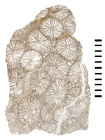
| Intro | | About | | Wiki | | Search traits | | Data explorer | | Literature | | Definitions | | Sources | | Webservices | | Statistics | | Feedback | | Editors | | Log in |
WoRMS taxon detailsAntiguastrea Vaughan, 1919 †
1347909 (urn:lsid:marinespecies.org:taxname:1347909)
accepted
Genus
Astraea cellulosa Duncan, 1863 † accepted as Antiguastrea cellulosa (Duncan, 1863) † (type by original designation)
Ellipsasteria Roniewicz, 1970 † · unaccepted > junior subjective synonym
marine,
fossil only
Vaughan TW. (1919). Contributions to the geology and paleontology of the Canal Zone, Panama, and geologically related areas in Central America and the West Indies. Fossil corals from central America, Cuba, and Porto Rico: with an account of the American Tertiary, Pleistocene, and recent coral reefs. <em>United States National Museum Bulletin.</em> 103: 189-524, pls. 68-152. [details]
Hoeksema, B. W.; Cairns, S. (2024). World List of Scleractinia. Antiguastrea Vaughan, 1919 †. Accessed through: World Register of Marine Species at: https://www.marinespecies.org/aphia.php?p=taxdetails&id=1347909 on 2024-07-16
Date action by
original description
Vaughan TW. (1919). Contributions to the geology and paleontology of the Canal Zone, Panama, and geologically related areas in Central America and the West Indies. Fossil corals from central America, Cuba, and Porto Rico: with an account of the American Tertiary, Pleistocene, and recent coral reefs. <em>United States National Museum Bulletin.</em> 103: 189-524, pls. 68-152. [details]
context source (Hexacorallia) Fautin, Daphne G. (2013). Hexacorallians of the World. (look up in IMIS) [details]  Present Present  Inaccurate Inaccurate  Introduced: alien Introduced: alien  Containing type locality Containing type locality
From editor or global species database
Comparison Antiguastrea is morphologically most similar to Tarbellastraea; both genera are plocoid with extracalicular budding, and have thin costae, a tabulo-vesicular coenosteum, and a lamellar columella. Antiguastrea differs from Tarbellastraea by having less coenosteum, larger corallites, more septal cycles, and better developed secondary septa. Antiguastrea is also similar to the Montastraea annularis complex in colony form, but differs by having a lamellar columella, thin costae, partially vesicular coenosteum, and weak septal dentition. It is assigned to the Family Merulinidae based on its similarity to the Montastraea annularis complex. [details]Diagnosis Subplocoid to plocoid colonies; extracalicular budding; cylindrical or subcylindrical corallites, > 3.5 mm in diameter; para- to septothecal; 3-5 septal cycles, with first and second cyles slightly subequal; weak or absent paliform lobes; well-developed lamellar columella; thin costae; tabulo-vesicular coenosteum; well-developed endotheca. [details] Remark The micromorphology and microstructure of Antiguastrea have not been studied in detail. Vaughan (1919, p. 401) described the septal margins as being "very obscurely dentate, subentire". [details] |

